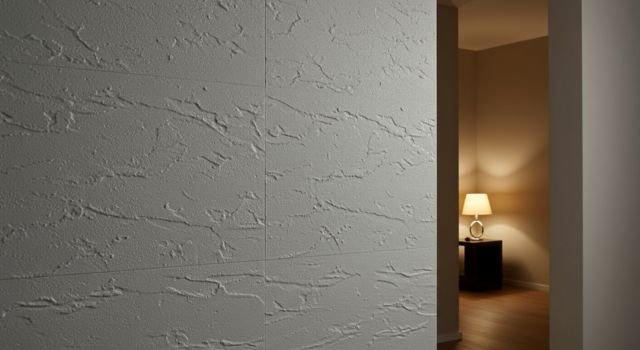Industrial environments such as manufacturing facilities, distribution centers and workshops are typically designed around efficiency, productivity and safety. These spaces are often filled with machinery, vehicles and hard surfaces that create high levels of background noise and echo. While such noise may seem unavoidable, excessive sound levels can impact worker well-being, concentration and even safety. Acoustic plaster offers an effective and visually unobtrusive way to reduce noise in industrial settings without compromising operational requirements. Here’s how—and why—it can be a smart addition to industrial spaces.
The Challenge of Industrial Acoustics
In industrial buildings, sound bounces off concrete floors, metal walls, and high ceilings, creating a loud, reverberant environment. This not only makes it difficult for workers to communicate with each other but also masks important auditory cues—such as warning signals or approaching vehicles. Over time, constant exposure to noise can lead to stress, fatigue and long-term hearing issues.
Typical acoustic solutions—like suspended acoustic tiles or fabric panels—may not be practical in industrial settings due to durability requirements, space constraints or contamination risks. Acoustic plaster provides an alternative solution that is both robust and seamlessly integrated into the building envelope.
How Acoustic Plaster Fits Industrial Needs
Acoustic plaster is applied directly to ceilings or upper wall surfaces, delivering broad-spectrum sound absorption without occupying floor or wall space that is needed for equipment, storage or operations. Its seamless finish eliminates joints and seams where dust, oil or particles might collect, making it a cleaner and more hygienic option than fabric-based systems.
Unlike many conventional treatments, acoustic plaster can be installed on curved or irregular surfaces—such as the underside of an arched roof or exposed concrete structure—without affecting its performance. In spaces where aesthetics still matter, such as customer-facing assembly areas or research labs, the clean and continuous appearance of acoustic plaster enhances the professional look of the environment.
Durability and Resistance
One of the most important considerations in industrial environments is durability. Acoustic plaster systems are specifically engineered to withstand demanding conditions. Most products have high surface hardness once cured and can resist minor impacts or abrasions. They also remain stable under variations in temperature and humidity, which is essential in facilities where production processes may generate heat or require ventilation.
In some facilities, washable or moisture-resistant acoustic plasters are available to accommodate wet or high-humidity conditions. These specialized formulations can be cleaned with a soft brush or damp cloth as required, adding to the long-term usability of the system.
Improving Safety and Communication
Noise is a recognized safety hazard in industrial settings. When reverberation is reduced, verbal instructions become clearer and warning signals become more easily identifiable. This can reduce the likelihood of accidents caused by miscommunication or missed cues.
Furthermore, improved acoustic conditions can support team collaboration. In large industrial halls where teams need to coordinate tasks verbally, being able to hear each other clearly improves efficiency and reduces mistakes. Even small improvements in speech clarity can have a measurable impact on operational performance.
Installation Considerations
Installing acoustic plaster in an industrial environment involves many of the same steps as in commercial settings, but with extra attention to planning and timing. The surface receiving the plaster must be clean, stable and free of contaminants. In operational facilities, this often means stopping production or isolating specific zones during installation. Contractors may also need to coordinate with facility managers to comply with safety protocols and avoid interference with sensitive equipment.
Some organizations choose to incorporate acoustic plaster during construction or major refurbishments to avoid downtime. Others implement it selectively in high-noise zones, such as around large machines or assembly areas, where sound absorption can deliver the biggest benefit.
Real-World Example
A large automotive supplier recently upgraded its production facility by integrating acoustic plaster into the ceilings above assembly lines. The design called for a solution that could improve speech intelligibility without reducing head clearance or interrupting workflow. FabriTech acoustic plaster was selected due to its seamless finish and high-performance NRC rating. After installation, the recorded reverberation time in the assembly area decreased significantly, making safety instructions easier to hear and reducing overall ambient noise levels. Workers reported feeling less fatigued by the end of each shift and communication between teams improved noticeably.
Long-Term Value
While the initial cost of acoustic plaster may be higher than simple acoustic panels, its long-term value in an industrial setting is notable. It doesn’t require replacement due to fabric discoloration, and it doesn’t interfere with equipment layouts or workflows. Because it is integrated into the building structure, it remains in place even as machinery and line layouts change over time, offering consistent acoustic performance throughout the life of the facility.
Final Thoughts
Industrial workplaces demand environments where efficiency and safety coexist. Acoustic plaster offers a practical and durable way to manage noise levels without disrupting operations or altering the functional layout of the facility. By reducing reverberation and enhancing clarity of speech and warning signals, it not only improves day-to-day comfort but also contributes to a safer and more productive work environment. For industrial leaders looking to invest in long-term acoustic solutions, acoustic plaster delivers a balanced, future-proof answer that aligns with both operational demands and human-centered design.




